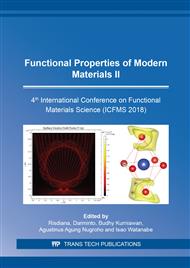[1]
Richard, et al, Karakteristik Sel Surya 20 WP dengan dan Tanpa Crackign System, Teknik Mesin Universitas HKBP Nommensen, Medan vol. 2 no. 1 (2016).
Google Scholar
[2]
O'regan and Gratzel, A Low-Cost, High Efficiency Solar Cell Based On Dye-Sensitized Colloidal TiO2 Films, Nature Vol. 353. Issue 6346, (1991) 737 - 740.
DOI: 10.1038/353737a0
Google Scholar
[3]
N. Puspitasari, N.A Silviyanti, G. Yudoyono, G. Prajitno, A. Rubiyanto, Endarko, Pengaruh Ketebalam Lapisan TiO2 terhadap Performasi Dye Sensitized Solar Cells, Jurnal Fisika dan Aplikasinya Volume 14 Nomor 1 (2018) 12-15.
DOI: 10.12962/j24604682.v14i1.3553
Google Scholar
[4]
Maulana, E. S. T., M. T., M. Eng., Sembiring, M. Aulia Rahman, Pramono. Sholeh Hadi, Pengaruh Variasi Ketebalan Titanitum Dioksida Terhadap Daya Keluaran DSSC, Jurnal Mahasiswa Teknik Elektro. Universitas Brawijaya. Malang (2015).
Google Scholar
[5]
Nur Widaryanti, H., n.d., Pembentukan Nanopartikel TiO2 Fasa Anatase dan Rutile dengan Metode Bervariasi, ITS Surabaya (2010).
Google Scholar
[6]
Kook, Lee Jin, Jeong Bo-Hwa, Jang Sung-il, Kim Young-Guen, Jang Yong-Wook, Lee Su-Bin, Kim Mi-Ra, Preparations of TiO2 pastes and its application to light-scattering layer for dye-sensitized solar cells, Journal of Industrial and Engineering Chemistry 15 (2009) 724-729.
DOI: 10.1109/pvsc.2008.4922656
Google Scholar
[7]
Nurrisma P, Nurul A.S, Gatut. Y, Endarko, Effect of Mixing Dyes and Solvent in Electrolyte Toward Characterization of Dye Sensitized Solar Cell Using Natural Dyes as The Sensitizer, IOP Conf. Series: Materials Science and Engineering 214 (2017) 012022.
DOI: 10.1088/1757-899x/214/1/012022
Google Scholar
[8]
Maddu, A., Zyhri, M., Irmasyah, Penggunaan Ekstrak Antosianin Kol Merah Sebagai Fotosensitizer Pada Sel Surya TiO2 Nanokristal Tersensitisasi Dye, Jurnal Matematika, Sains dan Teknologi MST Volume 11 (2010).
DOI: 10.7454/mst.v11i2.529
Google Scholar
[9]
Green, A. Martin, Solar Cells Operating Principles Technology and System Application, Prentice Hall Inc. Evylewood Cliffs (1982).
Google Scholar
[10]
Santoso, H., Zharvan V., Daniyati, R., Ichsan, N., Yudoyono G., Endarko, Peningkatan Dye-sensitized Solar Cell Menggunakan Metode Ultrasonifikasi, Jurnal Fisika dan Aplikasinya. Volume 11, No. 1 (2015).
DOI: 10.12962/j24604682.v11i1.783
Google Scholar
[11]
Tanaka, K, Capule, M F V, Hisanaga, T., Effect of crystallinity of TiO2 on its photocatalytic action, Chemical Physics Letters Volume 187 number 1,2, (1991) 73-76.
DOI: 10.1016/0009-2614(91)90486-s
Google Scholar
[12]
Senain, I., Nayan, N., Saim, H., Structural and Electrical Properties of TiO2 ThinFilm Derived from Sol-gel Method Using Titanium (IV) Butoxide, Microelectronic and Nanotechnology – Shamsuddin Research Center (MiNT-SRC) Faculty of Electrical and Electronic Engineering, UTHM. Malaysia (2009) 33.
DOI: 10.30880/ijie.2020.12.04.005
Google Scholar
[13]
Aziz, M. F. A., Hasiah S, et all, Electrical Conducticivity of Chlrorophyll with Polythiophene Thin Film on Indium Tin Oxide as P-N Heterojunction Solar Cell, American Institute of Physics (2009).
DOI: 10.1063/1.3160184
Google Scholar
[14]
Yuan, S., Tang, Q., He, B., Men, L., and Chen, H, Transmission Enhanced Photoanodes for Efficient Dye-sensitized Solar Cells, Electrochimia Acta 125, (2014) 646–651.
DOI: 10.1016/j.electacta.2014.02.017
Google Scholar
[15]
Arunachalam, A., Dhanapandian, S., and Manoharan, C, Effect of Sn doping on the structural, optical and electrical properties of TiO2 films prepared by spray pyrolysis, Physics E (2016) 35–46.
DOI: 10.1016/j.physe.2015.09.048
Google Scholar
[16]
C.Y. Huang, Y. C. Hsu, J. G. Chen, V. Suryanarayanan, K. M. Lee, K. C. Ho, Sol. Energy Matter, Sol. Cells 90, (2006) 2391-2397.
Google Scholar
[17]
Astuti and Henny, Pengaruh Penambahan Tembaga (Cu) Terhadap Sifat Listrik Polianilin (PANi), Laboratorium Fisika Material, Universitas Andalas Padang (2013).
DOI: 10.25077/jif.5.1.31-37.2013
Google Scholar


